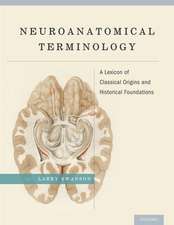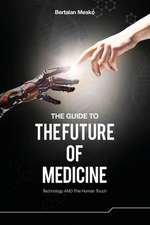Molecular Histochemical Techniques: Springer Lab Manuals
Editat de Takehiko Kojien Limba Engleză Paperback – 22 noi 2012
| Toate formatele și edițiile | Preț | Express |
|---|---|---|
| Paperback (1) | 695.85 lei 6-8 săpt. | |
| Springer – 22 noi 2012 | 695.85 lei 6-8 săpt. | |
| Hardback (1) | 947.04 lei 6-8 săpt. | |
| Springer – 17 apr 2000 | 947.04 lei 6-8 săpt. |
Din seria Springer Lab Manuals
-
 Preț: 385.84 lei
Preț: 385.84 lei -
 Preț: 362.59 lei
Preț: 362.59 lei - 18%
 Preț: 973.69 lei
Preț: 973.69 lei - 18%
 Preț: 997.40 lei
Preț: 997.40 lei -
 Preț: 385.84 lei
Preț: 385.84 lei -
 Preț: 382.18 lei
Preț: 382.18 lei - 24%
 Preț: 1045.10 lei
Preț: 1045.10 lei - 15%
 Preț: 641.20 lei
Preț: 641.20 lei - 18%
 Preț: 939.33 lei
Preț: 939.33 lei -
 Preț: 381.43 lei
Preț: 381.43 lei - 15%
 Preț: 637.59 lei
Preț: 637.59 lei - 15%
 Preț: 639.25 lei
Preț: 639.25 lei -
 Preț: 376.68 lei
Preț: 376.68 lei - 18%
 Preț: 1822.40 lei
Preț: 1822.40 lei - 18%
 Preț: 953.82 lei
Preț: 953.82 lei - 15%
 Preț: 645.14 lei
Preț: 645.14 lei - 15%
 Preț: 689.93 lei
Preț: 689.93 lei - 23%
 Preț: 821.59 lei
Preț: 821.59 lei - 19%
 Preț: 588.70 lei
Preț: 588.70 lei - 5%
 Preț: 727.44 lei
Preț: 727.44 lei - 18%
 Preț: 1225.31 lei
Preț: 1225.31 lei - 15%
 Preț: 657.39 lei
Preț: 657.39 lei - 18%
 Preț: 949.73 lei
Preț: 949.73 lei -
 Preț: 386.99 lei
Preț: 386.99 lei - 15%
 Preț: 657.25 lei
Preț: 657.25 lei - 19%
 Preț: 555.63 lei
Preț: 555.63 lei -
 Preț: 380.63 lei
Preț: 380.63 lei - 18%
 Preț: 1226.11 lei
Preț: 1226.11 lei - 15%
 Preț: 649.22 lei
Preț: 649.22 lei - 15%
 Preț: 632.55 lei
Preț: 632.55 lei - 19%
 Preț: 584.77 lei
Preț: 584.77 lei - 15%
 Preț: 639.41 lei
Preț: 639.41 lei - 15%
 Preț: 644.82 lei
Preț: 644.82 lei -
 Preț: 390.25 lei
Preț: 390.25 lei - 18%
 Preț: 781.31 lei
Preț: 781.31 lei - 15%
 Preț: 644.63 lei
Preț: 644.63 lei -
 Preț: 382.36 lei
Preț: 382.36 lei -
 Preț: 363.12 lei
Preț: 363.12 lei - 18%
 Preț: 961.23 lei
Preț: 961.23 lei -
 Preț: 416.29 lei
Preț: 416.29 lei - 18%
 Preț: 783.35 lei
Preț: 783.35 lei - 18%
 Preț: 791.88 lei
Preț: 791.88 lei - 15%
 Preț: 675.22 lei
Preț: 675.22 lei - 23%
 Preț: 1311.58 lei
Preț: 1311.58 lei -
 Preț: 381.43 lei
Preț: 381.43 lei
Preț: 695.85 lei
Preț vechi: 818.64 lei
-15% Nou
Puncte Express: 1044
Preț estimativ în valută:
133.16€ • 142.38$ • 111.02£
133.16€ • 142.38$ • 111.02£
Carte tipărită la comandă
Livrare economică 17 aprilie-01 mai
Preluare comenzi: 021 569.72.76
Specificații
ISBN-13: 9784431685203
ISBN-10: 4431685200
Pagini: 276
Ilustrații: X, 263 p.
Dimensiuni: 155 x 235 x 14 mm
Greutate: 0.39 kg
Ediția:2000
Editura: Springer
Colecția Springer
Seria Springer Lab Manuals
Locul publicării:Tokyo, Japan
ISBN-10: 4431685200
Pagini: 276
Ilustrații: X, 263 p.
Dimensiuni: 155 x 235 x 14 mm
Greutate: 0.39 kg
Ediția:2000
Editura: Springer
Colecția Springer
Seria Springer Lab Manuals
Locul publicării:Tokyo, Japan
Public țintă
ResearchCuprins
1 Introduction to the Detection of DNA Strand Breaks.- 2 In Situ Nick Translation.- 3 In Situ Nick End-Labeling: Light Microscopical.- 4 In Situ Nick End-Labeling: Electron Microscopical.- 5 Introduction to the Detection of Specific DNA and RNA Sequences.- 6 In Situ Hybridization for DNA: Fluorescent Probe.- 7 In Situ Hybridization for RNA: Radioactive DNA Probe.- 8 In Situ Hybridization for RNA: Radioactive RNA Probe — A Protocol for Practice With a Kit.- 9 In Situ Hybridization for RNA: Nonradioactive probe: ds cDNA Probe.- 10 In Situ Hybridization for RNA: Nonradioactive Probe: ss cDNA Probe.- 11 In Situ Hybridization for RNA: Nonradioactive Probe: Oligo-DNA Probe: T-T Dimer.- 12 In Situ Hybridization for RNA: Nonradioactive Probe: Oligo-DNA Probe: Digoxigenin (I).- 13 In Situ Hybridization for RNA: Nonradioactive Probe: Oligo-DNA Probe: Digoxigenin (II).- 14 In Situ Hybridization for RNA: Nonradioactive Probe: RNA Probe.- 15 Electron Microscopic in Situ Hybridization and its Combination With Immunohistochemistry.- 16 Whole Mount in Situ Hybridization for mRNA detection in Chick Embryos.- 17 Introduction to the Detection of Transcription Regulatory Proteins.- 18 Southwestern Histochemistry.
Textul de pe ultima copertă
Molecular Histochemical Techniques presents detailed protocols for analyzing DNA strand breaks, specific RNA/DNA expressions, and DNA binding proteins such as transcription factors at the individual cell level. In situ nick translation and TUNEL are described in detail, along with radioactive and nonradioactive methods for in situ hybridization. Of special significance is the description of Southwestern histochemistry, a new development in molecular histochemistry, which makes it possible to analyze the expression of transcription regulatory factors in individual cells. This volume provides an overview of the current status of molecular histochemistry along with practical how-to-do-it details. Methodology is set forth step-by-step in easy-to-follow language by leading scientists who are working in the field today. For researchers, laboratory technicians, and graduate students, the book serves as both a rich source of the latest information and a practical lab manual.
Caracteristici
Easy-to-follow step-by-step instructions for immediate use at the lab bench Protocols with a uniform clear structure and layout allow the techniques to be successfully reproduced All necessary practical details and notes as well as a troubleshooting section are included Up-to-date methods written by experts in their fields Includes supplementary material: sn.pub/extras















